Abstract
In order to decipher the functional genes and reveal the molecular mechanism of gonadal development in Macrobrachium rosenbergii, a comparative transcriptome analysis was performed on the testes and ovaries at different developmental stages. A total of 146,537 unigenes with an N50 of 2008 bp and an average length of 1144 bp were obtained from the sequencing raw data via quality control and denovo assembly. Identification of differentially expressed genes (DEGs) showed that there were 339 and 468 DEGs among the different developmental stages of testes and ovaries, respectively, and 7993 DEGs between the testes and ovaries. The KEGG enrichment analysis identified 13 candidate pathways related to gonadal development, including insulin synthesis, oocyte maturation, and steroid biosynthesis, which were involved in biological processes such as regulation of hormone metabolism, sex cell proliferation and development, and amino acid metabolism. The DEGs related to the above pathways such as insulin-like growth factor 1 receptor (IGF1R), heat shock protein 90 (Hsp 90), and cyclooxygenase (COX) genes were highly expressed during yolk protein synthesis, indicating that these genes might be involved in yolk accumulation and oogenesis. Meanwhile, calmodulin (CaM) and other genes were highly expressed during spermatogenesis, suggesting that these genes might play an important role in spermatogenesis. Ten differentially expressed genes in the KEGG signaling pathway, including CRQ, COX, APP, Cdc42, Hsd17b12, Art-1, Hsp70, Hsp90, PRMT1, and GP, were selected for real-time quantitative PCR (RT- qPCR) to validate the transcriptome data, and the results showed that RT- qPCR obtained consistent results with the RNA-Seq data. The present findings provide new insights into the molecular regulation mechanism of gonadal development in M. rosenbergii.
1. Introduction
The giant freshwater prawn (GFP) Macrobrachium rosenbergii, belonging to the phylum Arthropoda, order Decapoda, family Palaemonidae, and genus Macrobrachium, is native to tropical and subtropical regions, and is the largest cultured freshwater shrimp in the world. Because of its high economic value, short culture cycle, wide-ranging diet and other advantages, it has become an important economic species of freshwater shrimps. China introduced this species for farming in 1976 and has become its largest producer in the world, as China’s GFP production accounts for 50–60% of the world’s total production [1]. As an introduced species in China, there are some limitations such as a small effective population size, difficulty in obtaining post-larvae, and an unstable supply of high-quality post-larvae, resulting in an imbalance between the supply and demand of good post-larvae for GFP farming [2,3].
Growth and reproductive performance, as two major economic traits, can directly affect the efficiency and progress of the selective breeding of targeted varieties, thus affecting the development of the industry. Zhao [4] and Wang [5] investigated the structures of reproductive systems in M. rosenbergii females and males, respectively, and preliminarily staged the process of oogenesis and spermatogenesis; Zhu et al. [6] analyzed the expression of the foxl2 gene in the hepatopancreas and ovaries before and after sexual maturation in M. rosenbergii. These studies have provided us with a preliminary understanding of the structure of the reproductive system, gonadal development process and related functional genes in M. rosenbergii, but the molecular mechanisms of gonadal development and regulatory mechanisms still remain unknown. Currently, artificial nursing is often characterized by a lack of synchronization of female spawning, leading to an uneven larval catch, a longer nursing cycle, and higher costs [7]. Further investigations of the basic rules of gonadal development for M. rosenbergii can help to improve the synchronization of spawning by artificial intervention at key points of growth and reproduction, thus helping to improve the size and fertility of spawning individuals, and enhance the survival rate of post-larvae, which is an important prerequisite for culturing good breeding stocks.
In recent years, transcriptome sequencing has been widely used for the study of gene expression patterns in crustaceans [8], especially for non-model organisms that lack genomic information. In gonad-related transcriptomic studies, many authors have investigated the molecular mechanisms of gonadal development in cultured shrimps and crabs through transcriptome sequencing or by using candidate genes related to sex differentiation and gonadal development, and they also have explored more unknown related functional genes via transcriptome sequencing. For example, Wei et al. [9] identified genes related to gonadal development and maturation through a large-scale transcriptome study of the gonads in Litopenaeus vannamei, Jiang et al. [10] annotated a total of 36,282 genes related to sex in M. rosenbergii through gonadal transcriptome analysis, and detected gametocyte-specific factors (Gtsf), heat shock protein 21 (HSP21), male reproduction-related peptidase inhibitor Kazal-type (MRPINK) and 23 potential sex-related candidate genes, in addition to several sex-related KEGG pathways that also found. In Macrobrachium nipponense [11] and Eriocheir sinensis [12], researchers compared transcriptomic data between normally mature and precocious individuals to elucidate the phenomenon of precocious maturation, and screened for genes related to precocious maturation such as Vitellogenin (Vg), cyclooxygenase (COX), and glutathione peroxidase (gpx) in M. nipponense. In addition, some authors performed a comparative transcriptome analysis of gonads at different developmental stages. For example, Chen et al. [13] obtained 4592 differentially expressed genes via transcriptome analysis of two key developmental stages in Lysmata vittate and found some genes including insulin-like androgenic hormone (IAG), crustacean female sex hormone (CFSH), and gonad inhibiting hormone (GIH) as well as some pathways such as Wnt and ovarian steroid hormone biosynthesis that may be involved in their sex differentiation and gonadal development. Waiho et al. [14] identified the most significantly differentially expressed gene β lens protein-like via transcriptome analysis of the testes at three developmental stages for Scylla olivacea. Transcriptomic analysis of different developmental stages of gonads has become an important way to study the molecular and regulatory mechanisms of crustacean development.
Based on external morphology observations and a conventional histologic section of the M. rosenbergii gonads at different development stages, we have previously divided the development of its ovaries into eight periods and its testes into four periods [15]. In order to further explore the functional genes related to gonadal development and understand their expression patterns, we selected several key periods of gonadal development with obvious differences, and performed transcriptome analysis on the ovaries and testes. The present study will provide a theoretical basis for the selection of breeding stocks and new insights into the molecular regulation mechanism of gonadal development, further enriching the reproductive biology of M. rosenbergii.
2. Materials and Methods
2.1. Experimental Materials
Prawns used in the present study were the same age and were selected from nine families from the Breeding Center of Jiangsu Shufeng Prawn Breeding Co., Ltd. (Gaoyou, China). A total of 200 individuals at an age of around 80 days were selected to be cultured from each family, and the ratio of male to female was controlled at about 1:1. In total, 1800 prawns were cultured for investigating the external morphology and internal histology of the gonads (our published paper [15]) and for utilization in the transcriptome analysis in this study. Prawns from the nine families were placed separately in nine concrete ponds with an area of about 17 m2, and all culture conditions including the light (0~1380 lx), water temperature (28 °C~32 °C), and feed were kept consistent across all ponds. Water quality parameters were maintained at pH 7.5~8, dissolved oxygen 8~11 mg/L, ammonia nitrogen 0.05~0.25 mg/L, and nitrite 0.1~0.3 mg/L. Sampling was performed every week from 1 August 2020 to 4 October 2020, and each pond was sampled. Three males and three females were randomly caught for each sample from each pond, and the gonads were observed and sampled.
According to the division and identification of the gonadal developmental stages of M. rosenbergii as defined by Chen et al. [15], three individuals each with ovaries at Stage I, III, VI, VII, and VIII, and testes at Stage I, II, and III, were randomly sampled from the nine families and preserved in RNA-later for total RNA extraction and transcriptome sequencing.
2.2. Total RNA Extraction and Transcriptome Sequencing
Total RNA was extracted from each prawn’s gonad by using the conventional Trizol method. An ND-1000 spectrophotometer (NanoDrop, Wilmington, DE, USA) and 1% agarose gel electrophoresis were used to detect the RNA quality and concentration. The concentration of total RNA should be greater than 250 ng/μL with an OD260/OD280 value between 1.8 and 2.2 and an OD260/OD230 value greater than or equal to 2.0 to ensure no degradation and contamination of the RNA. The qualified total RNA was used for the following library construction and transcriptome sequencing, which was performed by Beijing Novogene Bioinformatics Technology Co. LTD. The sequencing platform Illumina Hiseq 2500 (Illumina, San Diego, CA, USA) was used.
2.3. Sequence Assembly and Gene Function Annotation
To ensure the quality and reliability of the data analysis, the raw sequencing data were controlled for quality by removing adapter-containing reads, reads including poly-N, and low-quality reads to obtain reliable, clean reads. Trimmomatic v0.35 (USADELLAB, USA) [16] was used for raw read trimming. Three independent software modules, cocoon, pupa and butterfly, which are based on Trinity-v2.4.0 software (The Broad Institute, Boston, MA, USA) [17], were adopted to splice the filtered clean reads to obtain transcripts (-min_kmer_cov: 3). On this basis, the redundancy was removed through Corset-version 4.6 (Nadia M Davidson, Alicia Oshlack, 2014) hierarchical clustering. Then, the length of transcripts and cluster sequences were counted, and the transcript sequence was used as the reference sequence. The longest transcript in each gene was used as the unigene. The BUSCO-v5.4.4 software (Benchmarking Universal Single-Copy Orthologs) (SIB, Geneva, Switzerland) [18] uses a single-copy orthologue gene library to assess the completeness of the assembled transcripts in combination with tblastn [19], augustus [20], and hmmer software [21]. To obtain more comprehensive gene function information, the unigenes were compared and annotated through seven public databases: NCBI Nt (non-redundant nucleotide sequences), NCBI Nr (non-redundant protein sequences), Pfam (protein families), KOG (EuKaryotic Orthologous Groups), Swiss-prot, KEGG (Kyoto Encyclopedia of Genes and Genomes), and GO (Gene Ontology) [22].
2.4. Identification of Differentially Expressed Genes, and GO and KEGG Enrichment Analysis
In this study, the FPKM (fragments per kilobase of exon model per million mapped fragments) method was used to calculate the expression of genes [23]. Differential expression analysis of two groups was performed using the DESeq2 R package (1.20.0). DESeq2 provides statistical routines for determining the differential expression in digital gene expression data using a model based on the negative binomial distribution. The criteria for screening differentially expressed genes (DEGs) are |log2 (fold change)| > 1 and FDR (false discovery rate) < 0.05 [24]. Under the threshold of a p-value ≤ 0.05, GO [25] and KEGG [26], enrichment analyses of DEGs were performed using GOSeq (1.10.0) (GAP TECH, Beijing, China) and KOBAS (v2.0.12) (Center for Bioinformatics, Peking University, China) packages, respectively. Moreover, their annotation information from the concomitant KEGG pathways, GO, and Pfam library databases was analyzed for a conclusive identification. Heatmaps visualizing gene differential expression were created using Gene Denovo.
2.5. Real-Time Quantitative PCR Validation of Differentially Expressed Genes
Based on the results of the transcriptome analysis, 10 DEGs were selected for real-time quantitative PCR (RT-qPCR) validation. The specific primers (Table 1) for each gene were designed using the Primer 6.0 software (Premier Biosoft, Palo Alto, CA, USA) and synthesized by Wuhan Tianyi Huayu Gene Technology Co., Ltd. The reverse transcription reaction system was a total of 30 μL, including 6 μL of 5 X PrimeScript RT Master Mix, 15 μL of total RNA, and 9 μL of RNase Free ddH2O. The reaction program included 37 °C for 15 min, then 85 °C for 5 s, and the obtained cDNA was stored at 4 °C for the following RT-qPCR, which was performed using the SYBR PreMix Ex Taq kit (TaKaRa, Dalian, China) with 18S rRNA as the reference gene. Three technical replicates were set up for each sample, and the reaction system totaled 25 μL, including 12.5 μL of TB Green Premix Ex Taq Ⅱ (2×), 9.5 μL of ddH2O, 1 μL each of forward and reverse primers, and 1 μL of cDNA. The CFX96 TouchTM RT-qPCR instrument (Bio-Rad, Hercules, CA, USA) was used. Based on the 2–ΔΔCT calculation method, the relative expression of the target gene in the samples was obtained, and the significance test was carried out using SPSS 25.0 (IBM, Chicago, IL, USA), and compared with the transcriptome sequencing data.

Table 1.
Primers used for the RT-qPCR analysis of the gonadal development in Macrobrachium rosenbergii.
3. Results
3.1. Transcript Assembly and Statistical Analysis
Transcriptome sequencing was performed on 15 ovarian samples from five different developmental stages of females, and a total of 352,975,807 raw reads were obtained, with an average of 23,531,720 raw reads per sample. A total of nine testicular samples from three different developmental stages of males were sequenced, and 210,202,884 raw reads were obtained, with an average of 23,355,876 raw reads per sample. After filtering, a total of 328,723,887 and 201,496,918 clean reads were obtained for the ovaries and testes, respectively, with a corresponding average of 21,914,926 and 22,388,546 per sample. Together, the clean data of each sample were more than 5.90 Gb, and all values of the Q20 and Q30 percentages were higher than 98% and 94%, respectively. The proportion of clean reads accounted for more than 94% of the raw data, and the N50 was 2008 bp (Table 2). The filtered data were assembled with Trinity software, and a total of 146,537 unigenes were obtained after hierarchical clustering with Corset, with a sequence length ranging from 301 bp to 28,406 bp and an average length of 1144 bp. A total of 60,907 unigenes had a length of 300–500 bp, accounting for 41.56% of the total number of unigenes. The second largest number of unigenes was 1001–2000 bp in length, numbering 20,749 and accounting for 14.16% of the total number of unigenes; 19,879 unigenes had a length of more than 2000 bp, accounting for 13.57% of the total number of unigenes (Figure 1). The BUSCO evaluation showed that the transcript completeness was 91%, indicating that the quality of data assembly was good.

Table 2.
Quality of transcriptome sequencing and assembly of the gonads in Macrobrachium rosenbergii.
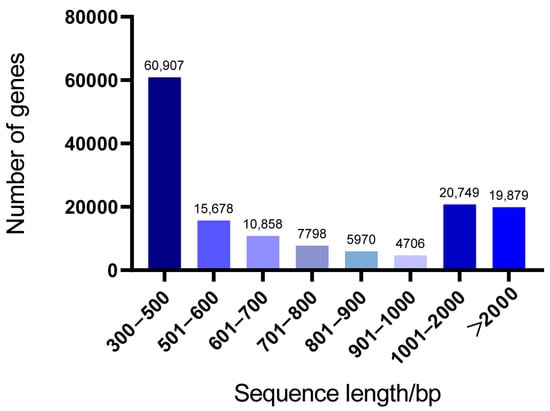
Figure 1.
Distribution of unigene length of the transcriptome in the gonads of Macrobrachium rosenbergii. The darker the color, the larger the number.
3.2. Functional Annotation and Classification of the Unigenes
The 146,537 unigenes obtained were annotated by using a homology search against seven public databases, including Nr, Nt, KO, Swiss-prot, Pfam, GO, and KOG, and 27,684 (18.89%), 7474 (5.10%), 8781(5.99%), 15,032 (10.25%), 30,530 (20.83%), 30,520 (20.82%), and 7278 (4.96%) unigenes were annotated in the corresponding database (Table 3). The 2148 genes are co-annotated by the five major databases, including Nt, Nr, KOG, GO and Pfam. Aligning the unigene sequences of M. rosenbergii with the Nr database, it was found that the sequence similarity with Litopenaeus vannamei was the highest, reaching 52.9%, and had a similarity of only 3.6%, 3.5%, and 2.0% with Mizuhopecten yessoensis, Hyalella azteca, and Apostichopus japonicus, respectively. The sequence similarity between M. rosenbergii and Armadillidium vulgare was the lowest at only 1.5%, indicating that the unigenes of the gonad transcriptomes in M. rosenbergii haves a high homology with L. vannamei.

Table 3.
Statistics of unigene annotations based on each of the seven databases.
Based on the annotated results from the GO database, 30,520 unigenes were classified into 42 subcategories of three GO categories including “Biological processes”, “Cellular components”, and “Molecular functions”. “Biological process” was the largest category, in which two subcategories, “Cellular processes” and “Metabolic process”, contained the largest number of unigenes at 17,872 and 14,495, respectively. Out of the “Cellular component” category, the subcategory “Cellular anatomical entity” consisted of the largest number of unigenes (15,176). In the “Molecular function” category, 14,449 unigenes were in the “Binding” subcategory, and 10,548 unigenes were related to “Catalytic activity” subcategory (Figure 2).
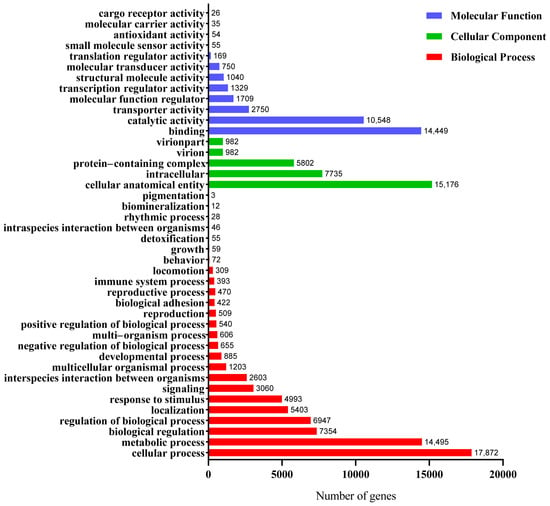
Figure 2.
GO annotation of the gonad transcriptome of Macrobrachium rosenbergii.
The KEGG database annotation results showed that a total of 8901 unigenes were classified into 35 different secondary pathways of 5 branches (branch A to E), among which the top three secondary pathways were “Signal transduction”, “Transportation and catabolism” and “Endocrine system”, where the number of unigenes included were 1084, 724, and 574, respectively (Figure 3).
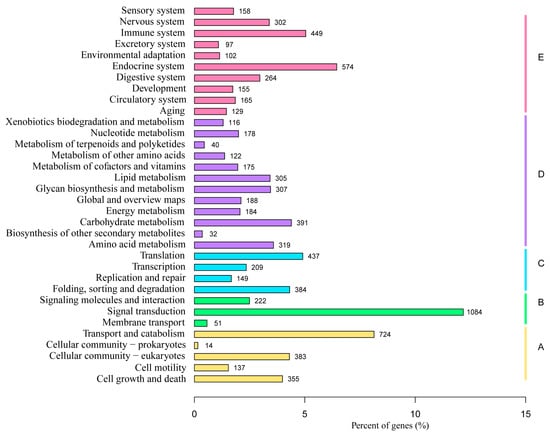
Figure 3.
Unigene KEGG enrichment classification of the gonad transcriptome of Macrobrachium rosenbergii.
3.3. Identification of Differentially Expressed Genes
The analysis of DEGs in the ovaries of M. rosenbergii at different developmental stages showed that the number of DEGs gradually increased with the development of the ovaries. There were 11,775 DEGs between the Stage I and Stage III ovaries (AC vs. DC), and 12,434 DEGs between the Stage I and Stage VII ovaries (AC vs. GC). However, the number of DEGs decreased to 10,184 when the ovaries finished ovipositing at the degenerative stage (Stage VIII), as compared to Stage I (AC vs. ZC). The data from the male testes showed an increasing number of DEGs as the testes developed, from 7277 between Stage I and Stage II (AX vs. BX) to 9197 between Stage I and Stage III (AX vs. DX) (Figure 4).
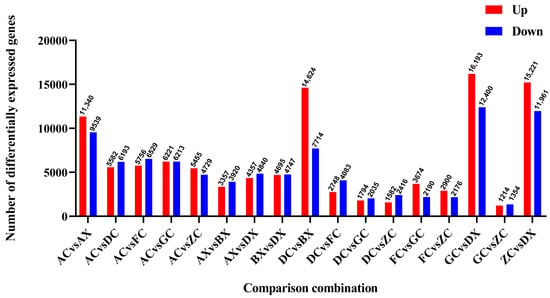
Figure 4.
Statistics of differentially expressed genes in different stages of gonadal development of Macrobrachium rosenbergii. AC—Stage I ovary; DC— Stage III ovary; FC—Stage VI ovary; GC—Stage VIII ovary; ZC—Stage VIII ovary; AX—Stage I testis; BX—Stage II testis; DX—Stage III testis.
The number of DEGs between the testes and ovaries were much more than that between ovaries or testes at different development stages, and also increased as the ovaries and testes developed, changing from 20,879 between Stage I ovaries and testes (AC vs. AX), to 22,338 at Stage II (DC vs. BX), and finally, to 28,593 at Stage III (GC vs. DX) (Figure 4).
Venn diagrams including the up- and down-regulated genes of three pairwise comparison showed that there was a total number of 339 common DEGs in the testes of male M. rosenbergii at different developmental stages (Figure 5a). There were 468 common DEGs among the top 5 DEG (the number of DEGs > 5000) pairwise comparison combinations between different development stages of female ovaries (Figure 5b). Moreover, a total of 7993 common DEGs were identified to be among the top 4 DEG (the number of DEGs > 20,000) pairwise comparison groups between testes and ovaries (Figure 5c).
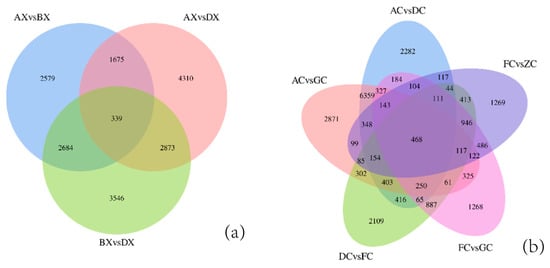
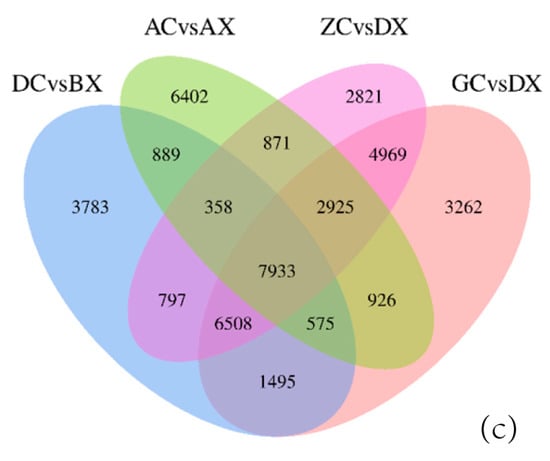
Figure 5.
Venn diagram of differentially expressed genes in different gonadal development stages of Macrobrachium rosenbergii. (a): three pairwise comparisons of the testes; (b): the top 5 DEG pairwise comparisons of ovaries; (c) the top 4 DEG pairwise comparisons between testes and ovaries. AC—Stage Ⅰ ovary; DC—Stage III ovary; FC—Stage VI ovary; GC—Stage VII ovary; ZC—Stage VIII ovary; AX—Stage Ⅰ testis; BX—Stage II testis; DX—Stage III testis.
3.4. KEGG Enrichment Analysis
Based on the KEGG enrichment analysis of the DEGs shared by testes or ovaries at different development stages, we found 13 KEGG signaling pathways that might be related to testis or ovary development; the pathways consisted of steroid biosynthesis, ovarian steroidogenesis, pantothenic acid and CoA biosynthesis, insulin secretion, fatty acid biosynthesis, the GnRH signaling pathway, steroid hormone biosynthesis, progesterone-mediated oocyte maturation, oocyte meiosis, unsaturated fatty acid biosynthesis, the insulin signaling pathway, the estrogen signaling pathway, arginine biosynthesis, and other signaling pathways. Among them, the insulin signaling pathway (involving 69 overlaping DEGs), oocyte meiosis (including 65 overlaping DEGs), the estrogen signaling pathway (59 common DEGs), and progesterone-mediated oocyte maturation (58 overlapping DEGs) were the top four pathways with the highest number of shared DEGs (Figure 6).
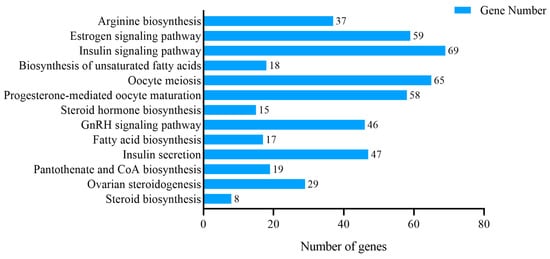
Figure 6.
The 13 KEGG pathways that might be related to the regulation of gonadal development in Macrobrachium rosenbergii. The value next to each bar is the number of the enriched common DEGs.
To investigate the relationship between different development stages and DEGs, 20 DEGs related to gonadal development were selected for DEG clustering analysis to show the expression pattern of DEGs. Heat maps of DEGs demonstrated that most genes were differentially expressed between testes and ovaries, and especially between ovaries in Stages III (DC), VI (FC), VII (GC), and VIII (ZC) and testes in each developmental period (AX, BX, and DX) (Figure 7). For example, the calmodulin gene (CaM) was consistently highly expressed in the developing testes of male, but was much less expressed in the developing ovaries. The croquet protein (CRQ), glycogen phosphorylase (GP), and insulin-like growth factor I receptor gene (IGF1R) were consistently highly expressed in the ovaries from the endogenous yolk synthesis stage (DC) to the maturation (ZC) of the ovaries, but was lowly expressed in the testes. The cell division regulatory protein 42 gene (Cdc 42) was highly expressed at the beginning of ovary development in female M. rosenbergii, whereas it was lowly expressed at the beginning of testis development. In addition, some genes were differentially expressed at different stages of testis or ovary development. For example, the cyclooxygenase gene (COX) and amyloid-beta-like protein (APP) were highly expressed when the female ovary enters the rapid developmental stage (FC), and the protein arginine methylesterase gene (PRMT1) was highly expressed when the ovary matured (GC), but they were lowly expressed during other periods of ovary development. For heat shock protein 90 (Hsp 90) gene members, Hsp 90-2, Hsp 90-4, and Hsp 90-5 were consistantly highly expressed after the initiation of yolk protein synthesis (DC) in the ovaries of M. rosenbergii, but was lowly expressed in the testes. Figure 8 shows the detailed expression level of several common EDGs in the KEGG signaling pathway related to gonadal development.
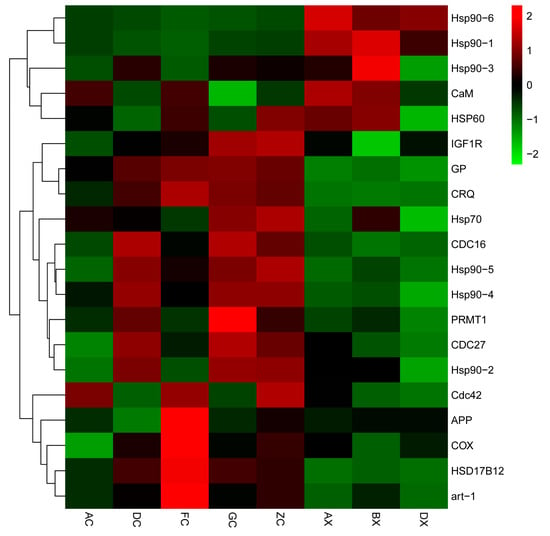
Figure 7.
Clustering and gene module heatmap of common differentially expressed genes in KEGG signaling pathway related to gonadal development. AC—Stage Ⅰ ovary; DC—Stage III ovary; FC—Stage VI ovary; GC—Stage VII ovary; ZC—Stage VIII ovary; AX—Stage Ⅰ testis; BX—Stage II testis; DX—Stage III testis.
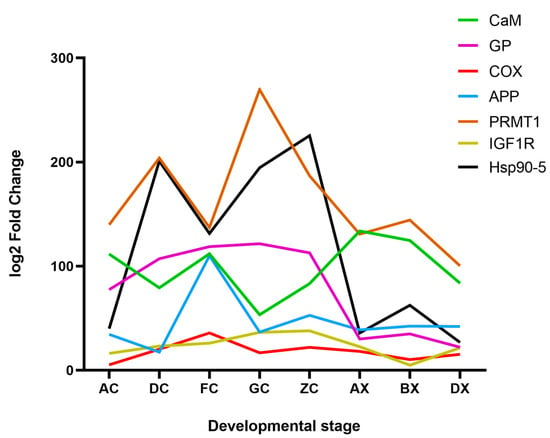
Figure 8.
Expression level of several common differentially expressed genes in KEGG signal pathway related to gonadal development. AC—Stage Ⅰ ovary; DC—Stage III ovary; FC—Stage VI ovary; GC—Stage VII ovary; ZC—Stage VIII ovary; AX—Stage I testis; BX—Stage II testis; DX—Stage III testis.
3.5. RT-qPCR Validation
Ten DEGs in the KEGG signaling pathway associated with gonadal development were selected for RT-qPCR validation. The selected genes included croquet protein (CRQ), cyclooxygenase (COX), amyloid-beta-like protein (APP), cell division control protein 42 (Cdc 42), hydroxysteroid (17-beta) dehydrogenase 12a (Hsd17b12), enoyl-CoA reductase-1 (Art-1), heat shock protein 70 (Hsp 70), heat shock protein 90 (Hsp 90), protein arginine methyltransferases 1 (PRMT 1), and glycogen phosphorylase (GP). RT-qPCR data are shown in Figure 9. The five down-regulated genes in the RNA-seq, CRQ, COX, Cdc 42, Art-1 and Hsp 90, were down-regulated in RT-qPCR as well, and the five up-regulated genes in the RNA-seq, APP, Hsd17b12, Hsp 70, PRMT 1, and GP, were up-regulated in the RT-qPCR validation. The validation results were basically consistent with the expression levels of the corresponding genes in the transcriptome, indicating that the transcriptomic data were reliable.
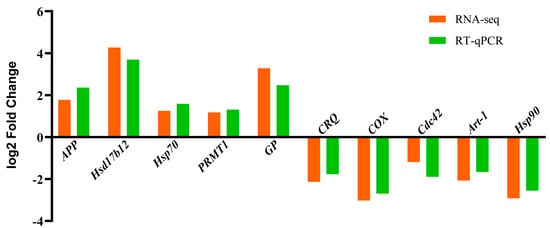
Figure 9.
Validation of DEGs by RT-qPCR.
4. Discussion
4.1. Analysis of Gonadal Development-Related Pathways
The KEGG enrichment analysis of metabolic pathways identified 13 signaling pathways related to gonadal development, including insulin synthesis, oocyte maturation, and steroid biosynthesis, which involve biological processes such as the regulation of hormone metabolism, sex cell proliferation and development, and amino acid metabolism. Arginine as an essential component of sperm nucleoprotein is involved in sperm formation in male individuals [27]; in Salmo trutta, the secretion level of insulin-like growth factor I (IGF-I) can be raised via an intraperitoneal injection of arginine [28]. Insulin-like growth factors (IGFs) are involved in the regulation of gonadal developmental processes and meanwhile may affect the growth and development of individuals [29,30]. The present transcriptome analysis showed that there were differentially expressed genes in the arginine biosynthesis pathway at different development stages for female ovaries and male testes. Thus, it is hypothesized that arginine biosynthesis might indirectly regulate testis and ovary development by promoting growth and gonadal development-related hormone secretion.
Dynamic changes in animal energy metabolism directly influence the secretion level of reproduction-related hormones, thus affecting individual reproductive performance. Insulin is a key hormone involved in the regulation of energy metabolism, whereas gonadotropin-releasing hormone (GnRH) is an important hormone related to gonadal development and reproduction. Insulin generally regulates gonadal development and reproduction via its impact on the secretion level of GnRH [31], and the regulatory pathways include the following three: (1) promoting the binding of early growth response protein-1 (Egr-1) to the GnRH promoter, in order to up-regulate GnRH promoter activity and the consequent high GnRH expression [32]; (2) influencing GnRH expression by affecting extracellular signal-regulated kinase (ERK) activity in the presence of follicle stimulating hormone (FSH) and luteinizing hormone (LH) [33,34]; and (3) regulating GnRH expression by enhancing neuropeptide Y (NPY) activity [35]. The present results show that DEGs were detected in insulin- and GnRH-related signaling pathways in testes and ovaries at different developmental stages, indicating that the gonadal development process in M. rosenbergii is closely related to the individual growth and energy metabolism of the organism.
Pantothenic acid, switching to coenzyme A (CoA), becomes involved in fatty acid metabolism. CoA is involved in the metabolism of glucose and lipids, providing 90% of the energy for body consumption. In addition, pantothenic acid is also involved in the synthesis and metabolism of steroids, which can be used as substance for fatty acid synthesis. Sex steroid hormones such as progesterone, 17β-estradiol and testosterone are key regulatory hormones of gonadal development. Ovarian steroids were found to have effects on the formation of the yolk, as well as the proliferation, development, and maturation of the zygote in M. rosenbergii [36]. Testosterone was found to induce spermatozoal development in male Chinese mitten crab (Eriocheir sinensis), whereas 17β-estradiol can induce the transfer of liver nutrients into ovaries in female crabs, accelerating ovarian nutrient accumulation and promoting ovarian development [37]. The results of this study showed that a significantly differential expression existed between the gonads of M. rosenbergii males and females in the pathways related to the synthesis of steroids, fatty acids, pantothenic acid and CoA, indicating that these pathways might play an important regulatory role in gametogenesis and yolk accumulation in M. rosenbergii.
4.2. Key Differentially Expressed Genes Related to Gonadal Development
The present study showed that several genes such as IGF1R, CaM, Hsp90, COX, and PRMT1 might play important roles in regulating gonadal development in M. rosenbergii.
IGF1R is an insulin-like growth factor 1 membrane receptor. The insulin-like protein family includes insulin-like peptides (ILPs) and insulin-like growth factors (IGFs) [38,39]. Both IGF-1 and IGF1R are members of the insulin-like protein family. IGF-1 regulates cell mitosis and cell differentiation, participating in growth, sexual differentiation, and the reproduction process [40]. IGF1R acts as a receptor for IGF-I in vertebrates, which can accelerate the proliferation of ovarian mesenchymal cells while promoting DNA synthesis [41]. In invertebrates, such as Macrobrachium nipponense, the high-expression of the IGF1R gene implies the massive production of IGF-1, which promotes yolk synthesis, oogenesis, and sexual maturation in females [11]. In Drosophila, insulin-like growth factor signaling pathways, including IGF-1 and IGF1R, have been proved to be linked to yolk formation, oogenesis, and juvenile hormone-related reproductive delay [42]. The present results show that the IGF1R gene was consistently highly expressed in female M. rosenbergii ovaries after entering the phase of endogenous yolk protein synthesis, whereas it was lowly-expressed in ovaries at the early stages, suggesting that IGF1R might contribute to yolk formation in female M. rosenbergii.
CaM is a calmodulin, which is involved in cell proliferation and differentiation by binding to Ca2+. Studies in amphibian and fish oocytes during early development have shown that CaM is involved in the release of gonadotropin-like hormone in the GnRH signaling pathway by activating the calmodulin kinase (CaM kinase). CaM accelerates oocyte development by promoting the synthesis and expression of factors related to the sex hormone synthesis pathways and oocyte maturation pathways, such as estradiol and progesterone [43]. Studies in mammals have concluded that CaM is closely related to mammalian spermatogenesis, flagellar motility, the acrosome reaction, and sperm–egg fusion [44]. The current results show that the CaM gene was highly expressed during the development of testes, but the expression level was low during ovary development, indicating that CaM might contribute to accelerating spermatogonia proliferation and maturation. However, its function of inducing egg maturation in female M. rosenbergii needs to be further proved.
In oviparous animals, estrogen can upregulate transcriptional levels of the vitellogenin (Vg) gene and accelerate the accumulation of yolk protein in the ovaries [45]. Researchers have considered that there may be a heat shock protein 90-vitellogenin (HSP90-Vg) molecular regulatory channel, which means Hsp90 can bind to estrogen receptors in the absence of estrogen and perform an estrogen-like function, consequently upregulating the transcription of the Vg gene and accelerating the synthesis of Vg [46]. This study shows that some Hsp90 gene members was consistently highly expressed after the initiation of yolk protein synthesis (Stage III) in the ovaries of M. rosenbergii. Therefore, it was hypothesized that the some Hsp90 gene members might have a significant impact on the accumulation of the yolk protein in female M. rosenbergii.
Protein arginine methylesterase (PRMT1), which is responsible for the methylation of protein arginine substrates and protein methylation modifications, is involved in cellular signaling transcription, RNA splicing, transcriptional regulation, and other biological processes [47]. In Artemia sinica, the PRMT1 gene was expressed at all stages throughout embryonic development, peaking at the flourishing period of development. The expression of PRMT1 gradually decreased in adulthood, suggesting that PRMT1 can regulate the process of embryonic development [48]. In transcriptomic data from the testes and ovaries of Oratosquilla oratoria [49], researchers screened for the PRMT1 gene as a candidate for germ cell differentiation and development regulation. The present results showed that PRMT1 gene expression was significantly up-regulated during the rapid developmental stages (Stages IV, V and VI) and significantly down-regulated during the degenerative stage (Stage VIII) in the ovaries of M. rosenbergii, suggesting that PRMT1 might play a vital role in inducing the maturation of ovaries.
Cyclooxygenase (COX) can catalyze the production of prostaglandins (PGs) from arachidonic acid (AA). PGs have effects on ovarian maturation in females [50]. Studies on Cancer pagurus have shown that PG levels gradually increases as the ovaries mature [51]. There was a high level of PGs in the early development stages of ovaries in Panulirus japonicus and PG levels gradually decreased as the ovaries matured [52]. There was a lower expression of the COX gene in premature female M. rosenbergii compared to mature individuals, indirectly suggesting that the PG level affects the development of ovaries in M. rosenbergii females [11]. This study found that the expression level of the COX gene was significantly up-regulated when the ovaries entered the rapid development stage (Stage IV, V, and VI), whereas it was significantly down-regulated in the early stages of ovarian development (Stage I, II, and III) and in the mature stage (Stage VII). The expression of the COX gene in the testes always remained low, suggesting that the COX gene might be attributed to the acceleration of ovarian maturation in M. rosenbergii.
In addition, the present study indicated that amyloid-beta-like protein (APP) and the glycogen phosphorylase (GP) also might play an important regulatory role in the gonadal development of M. rosenbergii, but few studies have been performed on their functions.
Ultimately, the development of gonads is a complicated process that involves a large number of genes and their regulation. The detailed function of the genes related to gonadal development found in this study need be further proved in future investigations.
5. Conclusions
In conclusion, the transcriptomic data obtained from several different developmental periods of ovaries and testes of M. rosenbergii, involved 146,537 unigenes, enriching the database of gonadal development-related genes in M. rosenbergii. Transcriptomic comparisons of testes and ovaries at different developmental stages helped identify 13 key pathways (steroid biosynthesis, arginine biosynthesis, GnRH signaling pathway, etc.) that might be involved in the gonadal development of M. rosenbergii. These pathways are mainly involved in hormone regulation, gonadal cell proliferation, and amino acid metabolism. Importantly, some key genes (IGF1R, CaM, Hsp90, COX, PRMT1, etc.) were detected, which might contribute to gonadal developmental regulation, hormone metabolism, gametogenesis, yolk accumulation, etc. The present results can provide basic information for further investigations on the mechanisms of sex differences and the molecular regulation of gonadal development in M. rosenbergii.
Author Contributions
Conceptualization, Z.Z. and G.C.; methodology, H.T.; software, X.Y.; validation, X.P. and X.L.; formal analysis, S.Y.; investigation, Z.X.; resources, M.C.; project administration, Q.T.; funding acquisition, G.Y. All authors have read and agreed to the published version of the manuscript.
Funding
This research was funded by National Key R&D Programme of China for Blue Granary (number: 2018YFD0901300), The Major Research & Development Programme (Modern Agriculture) of Jiangsu Province (number: BE2019352), The Earmarked Fund (number: CARS-48), Special Funds for Major Science and Technology of Breeding New Agriculture (aquatic) Varieties in Zhejiang province (number: 2021C02069–4-3).
Institutional Review Board Statement
This study was conducted according to the Guide for Laboratory Animals developed by the Ministry of Science and Technology (Beijing, China). The experimental protocol for animal care and tissue collection was approved by Huzhou University (the ethical approval code: 20190625).
Informed Consent Statement
Not applicable.
Data Availability Statement
All supporting data are included within the main article.
Acknowledgments
We thank Houkuan Du, Jie Yang, Minmin Yang, and Qianqian Xing for their help in sample and data collection. Thanks are also given to two anonymous reviewers and editors for their valuable advice on revising our manuscript.
Conflicts of Interest
The authors declare no conflict of interest.
References
- Fao, F.; Bondad-Reantaso, M.G.; Arthur, J.R. FAO Fisheries and Aquaculture Report NFIA/R1333 (En); FAO: Rome, Italy, 2021. [Google Scholar]
- Zhou, J.S.; Cao, Z.M.; Yang, G.L.; Li, J.L.; Zhang, Z.W.; Wu, T.T. Study on hybrid of burma introduced and Zhejiang locally-cultured populations of giant prawn Macrobrachium rosenbergii de man and SRAP marker. J. Fish. Sci. China 2006, 13, 667–673. [Google Scholar]
- Luo, K.; Yang, G.L.; Kong, J.; Zhang, Y.F.; Wang, J.Y.; Gong, J.H.; Gao, Q. Analysis of the effect of hybridization between different groups of Macrobrachium rosenbergii. Mar. Fish. Res. 2008, 29, 67–73. [Google Scholar]
- Zhao, Y.L.; Peng, X.X.; Li, X. Histological study on the female reproductive system of Macrobrachium rosenbergii. J. East China Norm. Univ. (Nat. Sci.) 1998, 3, 81–85. [Google Scholar]
- Wang, Y.F.; Du, N.S.; Lai, W. Histochemical tudy on the male reproductive system of Macrobrachium rosenbergii. J. Fish. Sci. China 1997, 4, 14–17. [Google Scholar]
- Zhu, Y.K.; Chen, H.L.; Wei, Y.F.; Wang, W.M. Effects of Mrfoxl 2-dsRNA on the expression of foxl 2 and reproduction-related genes in the ovariesof Macrobrachium rosenbergii. Freshw. Fish. 2022, 52, 38–43. [Google Scholar] [CrossRef]
- Chen, X.F.; Wang, C.L.; Gu, Z.M.; Xu, B.P.; Zhang, Y.F.; Shen, P.J.; Cheng, H.H.; Peng, F.; Li, X.L.; Huang, Z.Y. Transcriptome analysis of Macrobrachium rosenbergii ovary in four development stages. Oceanol. Et Limnol. Sin. 2019, 50, 398–408. [Google Scholar]
- Jia, C.L.; Zhang, Y.; Zhu, L.; Zhang, R. Application progress of transcriptome sequencing technology in biological sequencing. Mol. Plant Breed. 2015, 13, 2388–2394. [Google Scholar] [CrossRef]
- Wei, P.Y. Transcriptome and Identification of Differently Experesing Genes in the Testis and Ovary of Pacific White Shrimp LitopenaeusI Vannamei Broodstock. Master’s Thesis, Guangxi University, Nanning, China, 2017. [Google Scholar]
- Jiang, J.; Yuan, X.; Qiu, Q.; Huang, G.; Jiang, Q.; Fu, P.; Zhang, Y.; Jia, Y.; Yang, X.; Jiang, H. Comparative transcriptome analysis of gonads for the identification of sex-related genes in giant freshwater prawns (Macrobrachium rosenbergii) using RNA sequencing. Genes 2019, 10, 1035. [Google Scholar] [CrossRef]
- Jiang, H.X. Screening, Cloning, Expression and Functional Analysis of Sexual Precocity Related Genes in Female Macrobrachium Nipponense. Ph.D. Thesis, North West Agriculture and Forestry University, Xianyang, China, 2017. [Google Scholar]
- Ci, Y.J. Preliminary Study on Molecular Mechanism of Precious Chinese Mitten Crab. Master’s Thesis, Shanghai Ocean University, Shanghai, China, 2015. [Google Scholar]
- Chen, D.M. Ontogenetic Development of Gonads and Transcriptomeanalysis of the Peppermint Shrimp, Lysmata vittata. Master’s Thesis, Xiamen University, Xiamen, China, 2019. [Google Scholar]
- Waiho, K.; Fazhan, H.; Shahreza, M.S.; Moh, J.H.Z.; Noorbaiduri, S.; Wong, L.L.; Sinnasamy, S.; Ikhwanuddin, M. Transcriptome analysis and differential gene expression on the testis of orange mud crab, Scylla olivacea, during sexual maturation. PLoS ONE 2017, 12, e0171095. [Google Scholar] [CrossRef]
- Chen, G.Z.; Zhong, Z.X.; Yang, M.M.; Xing, Q.Q.; Xia, Z.L.; Tang, Q.Y.; Yi, S.K.; Cai, M.Y.; Yang, J.; Yang, G.L. Histological observation of gonad development during the first sexual maturity of Macrobrachium rosenbergii. Oceanol. Et Limnol. Sin. 2022, 53, 1208–1218. [Google Scholar]
- Bolger, A.M.; Lohse, M.; Usadel, B. Trimmomatic: A flexible trimmer for Illumina sequence data. Bioinformatics 2014, 30, 2114–2120. [Google Scholar] [CrossRef]
- Grabherr, M.G.; Haas, B.J.; Yassour, M.; Levin, J.Z.; Thompson, D.A.; Amit, I.; Adiconis, X.; Fan, L.; Raychowdhury, R.; Zeng, Q.; et al. Full-length transcriptome assembly from RNA-Seq data without a reference genome. Nat. Biotechnol. 2011, 29, 644–652. [Google Scholar] [CrossRef]
- Manni, M.; Berkeley, M.R.; Seppey, M.; Simão, F.A.; Zdobnov, E.M. BUSCO Update: Novel and streamlined workflows along with broader and deeper phylogenetic coverage for scoring of eukaryotic, prokaryotic, and Viral Genomes. Mol. Biol. Evol. 2021, 38, 4647–4654. [Google Scholar] [CrossRef] [PubMed]
- Rossi, A.; Deveraux, Q.; Turk, B.; Sali, A. Comprehensive search for cysteine cathepsins in the human genome. Biol. Chem. 2004, 385, 363–372. [Google Scholar] [CrossRef] [PubMed]
- Mario, S.; Burkhard, M. AUGUSTUS: A web server for gene prediction in eukaryotes that allows user-defined constraints. Nucleic Acids Res. 2005, 33, W465–W467. [Google Scholar]
- Jaina, M.; Finn, R.D.; Eddy, S.R.; Alex, B.; Marco, P. Challenges in homology search: HMMER3 and convergent evolution of coiled-coil regions. Nucleic Acids Res. 2013, 41, e121. [Google Scholar]
- Kanehisa, M.; Araki, M.; Goto, S.; Hattori, M.; Hirakawa, M.; Itoh, M.; Katayama, T.; Kawashima, S.; Okuda, S.; Tokimatsu, T.; et al. KEGG for linking genomes to life and the environment. Nucleic Acids Res. 2007, 36, D480–D484. [Google Scholar] [CrossRef]
- Trapnell, C.; Williams, B.A.; Pertea, G.; Mortazavi, A.; Kwan, G.; van Baren, M.J.; Salzberg, S.L.; Wold, B.J.; Pachter, L. Transcript assembly and quantification by RNA-Seq reveals unannotated transcripts and isoform switching during cell differentiation. Nat. Biotechnol. 2010, 28, 511–515. [Google Scholar] [CrossRef]
- Anders, S.; Huber, W. Differential expression analysis for sequence count data. Nat. Preced. 2010, 11, R106. [Google Scholar] [CrossRef]
- Young, M.D.; Wakefield, M.J.; Smyth, G.K.; Oshlack, A. Gene ontology analysis for RNA-seq: Accounting for selection bias. Genome Biol. 2010, 11, R14. [Google Scholar] [CrossRef]
- Mao, X.; Cai, T.; Olyarchuk, J.G.; Wei, L. Automated genome annotation and pathway identification using the KEGG Orthology (KO) as a controlled vocabulary. Bioinformatics 2005, 21, 3787–3793. [Google Scholar] [CrossRef] [PubMed]
- Zhang, F.Y.; Wang, N.; Wang, C.A.; Qu, S. Biological Functions of Arginine. Feed Res. 2009, 2, 16–18. [Google Scholar]
- Baños, N.; Planas, J.V.; Gutiérrez, J.; Navarro, I. Regulation of plasma insulin-like growth factor-I levels in brown trout (Salmo trutta). Comp. Biochem. Physiol. Part C Pharmacol. Toxicol. Endocrinol. 1999, 124, 33–40. [Google Scholar] [CrossRef] [PubMed]
- Jiao, B.; Huang, X.; Chan, C.B.; Zhang, L.; Wang, D.; Cheng, C.H.K. The co-existence of two growth hormone receptors in teleost fish and their differential signal transduction, tissue distribution and hormonal regulation of expression in seabream. J. Mol. Endocrinol. 2006, 36, 23–40. [Google Scholar] [CrossRef] [PubMed]
- Wang, D.-S.; Jiao, B.; Hu, C.; Huang, X.; Liu, Z.; Cheng, C.H.K. Discovery of a gonad-specific IGF subtype in teleost. Biochem. Biophys. Res. Commun. 2008, 367, 336–341. [Google Scholar] [CrossRef]
- Zhu, Y.J.; Ding, L.; Zhang, Y.; Wang, Y.; Zhang, B.S. Regulation of Insulin in Secretion and Activity of Gonadotropin-Releasing Hormone. Chin. J. Anim. Nutr. 2013, 25, 1–7. [Google Scholar]
- DiVall, S.A.; Radovick, S.; Wolfe, A. Egr-1 binds the GnRH promoter to mediate the increase in gene expression by insulin. Mol. Cell. Endocrinol. 2007, 270, 64–72. [Google Scholar] [CrossRef]
- Liu, F.; Usui, I.; Evans, L.G.; Austin, D.A.; Mellon, P.L.; Olefsky, J.M.; Webster, N.J. Involvement of both G(q/11) and G(s) proteins in gonadotropin-releasing hormone receptor-mediated signaling in L beta T2 cells. J. Biol. Chem. 2002, 277, 32099–32108. [Google Scholar] [CrossRef] [PubMed]
- Navratil, A.M.; Song, H.; Hernandez, J.B.; Cherrington, B.D.; Santos, S.J.; Low, J.M.; Do, M.-H.T.; Lawson, M.A. Insulin augments gonadotropin-releasing hormone induction of translation in LβT2 cells. Mol. Cell. Endocrinol. 2009, 311, 47–54. [Google Scholar] [CrossRef]
- Xu, J.; Kirigiti, M.A.; Grove, K.L.; Smith, M.S. Regulation of Food Intake and Gonadotropin-Releasing Hormone/Luteinizing Hormone during Lactation: Role of Insulin and Leptin. Endocrinology 2009, 150, 4231–4240. [Google Scholar] [CrossRef]
- Soonthornsumrith, B.; Saetan, J.; Kruangkum, T.; Thongbuakaew, T.; Senarai, T.; Palasoon, R.; Sobhon, P.; Sretarugsa, P. Three-dimensional organization of the brain and distribution of serotonin in the brain and ovary, and its effects on ovarian steroidogenesis in the giant freshwater prawn, Macrobrachium rosenbergii. Invertebr. Neurosci. 2018, 18, 5. [Google Scholar] [CrossRef] [PubMed]
- Jiang, R.L.; Tan, Y.J.; Wu, J.M.; Yan, X.Z.; Bao, X.S.; Yao, J.M. Changes of Hemolymph 20-hydroxyecdysone 17β-oestradiol and Testosteronelevels in Eriocheir Sinensis. J. Fish. China. 1992, 16, 101–106. [Google Scholar]
- Chandler, J.C.; Aizen, J.; Elizur, A.; Hollander-Cohen, L.; Battaglene, S.C.; Ventura, T. Discovery of a novel insulin-like peptide and insulin binding proteins in the Eastern rock lobster Sagmariasus verreauxi. Gen. Comp. Endocrinol. 2015, 215, 76–87. [Google Scholar] [CrossRef] [PubMed]
- Dircksen, H.; Neupert, S.; Predel, R.; Verleyen, P.; Huybrechts, J.; Strauss, J.; Hauser, F.; Stafflinger, E.; Schneider, M.; Pauwels, K.; et al. Genomics, Transcriptomics, and Peptidomics of Daphnia pulex Neuropeptides and Protein Hormones. J. Proteome Res. 2011, 10, 4478–4504. [Google Scholar] [CrossRef]
- Reinecke, M.; Björnsson, B.T.; Dickhoff, W.W.; McCormick, S.D.; Navarro, I.; Power, D.M.; Gutiérrez, J. Growth hormone and insulin-like growth factors in fish: Where we are and where to go. Gen. Comp. Endocrinol. 2005, 142, 20–24. [Google Scholar] [CrossRef]
- Duleba, A.J.; Spaczynski, R.Z.; Olive, D.L. Insulin and insulin-like growth factor I stimulate the proliferation of human ovarian theca-interstitial cells. Fertil. Steril. 1998, 69, 335–340. [Google Scholar] [CrossRef] [PubMed]
- Brogiolo, W.; Stocker, H.; Ikeya, T.; Rintelen, F.; Fernandez, R.; Hafen, E. An evolutionarily conserved function of the Drosophila insulin receptor and insulin-like peptides in growth control. Curr. Biol. 2001, 11, 213–221. [Google Scholar] [CrossRef]
- Benninghoff, A.D.; Thomas, P. Involvement of calcium and calmodulin in the regulation of ovarian steroidogenesis in Atlantic croaker (Micropogonias undulatus) and modulation by Aroclor 1254. Gen. Comp. Endocrinol. 2005, 144, 211–223. [Google Scholar] [CrossRef]
- Wang, A.X. Calmodulin and Sperm Function. Int. J. Urol. Nephrol. 1996, 4, 177–179. [Google Scholar]
- Örn, S.; Yamani, S.; Norrgren, L. Comparison of Vitellogenin Induction, Sex Ratio, and Gonad Morphology between Zebrafish and Japanese Medaka after Exposure to 17α-Ethinylestradiol and 17β-Trenbolone. Arch. Environ. Contam. Toxicol. 2006, 51, 237–243. [Google Scholar] [CrossRef]
- Brown, M.A.; Zhu, L.; Schmidt, C.; Tucker, P.W. Hsp90—From signal transduction to cell transformation. Biochem. Biophys. Res. Commun. 2007, 363, 241–246. [Google Scholar] [CrossRef] [PubMed]
- Yin, Y. Expression and Function Analysis of Porcine PRMTI Gene. Master’s Thesis, Xinyang Normal University, Xinyang, China, 2017. [Google Scholar]
- Jiang, X. Molecular Cloning, Characterization and Expression Analysis of Proteinarginine N-methyltransferase 1 gene (As-PRMTI) from Artemia sinica. Master’s Thesis, Liaoning Normal University, Dalian, China, 2015. [Google Scholar]
- Yan, H.; Cui, X.; Shen, X.; Wang, L.; Jiang, L.; Liu, H.; Liu, Y.; Liu, Q.; Jiang, C. De novo transcriptome analysis and differentially expressed genes in the ovary and testis of the Japanese mantis shrimp Oratosquilla oratoria by RNA-Seq. Comp. Biochem. Physiol. Part D Genom. Proteom. 2018, 26, 69–78. [Google Scholar] [CrossRef] [PubMed]
- Xing, J.B.; You, J.G.; Li, X.; Yong, G. Research progress of prostaglandins in aquatic animals. Jiangxi Fish. Sci. Technol. 2019, 168, 41–43. [Google Scholar]
- Sreenivasula Reddy, P.; Ramachandra Reddy, P.; Purna Chandra Nagaraju, G. The synthesis and effects of prostaglandins on the ovary of the crab Oziotelphusa senex senex. Gen. Comp. Endocrinol. 2004, 135, 35–41. [Google Scholar] [CrossRef] [PubMed]
- Tahara, D.; Yano, I. Maturation-related variations in prostaglandin and fatty acid content of ovary in the kuruma prawn (Marsupenaeus japonicus). Comp. Biochem. Physiol. Part A Mol. Integr. Physiol. 2004, 137, 631–637. [Google Scholar] [CrossRef] [PubMed]
Disclaimer/Publisher’s Note: The statements, opinions and data contained in all publications are solely those of the individual author(s) and contributor(s) and not of MDPI and/or the editor(s). MDPI and/or the editor(s) disclaim responsibility for any injury to people or property resulting from any ideas, methods, instructions or products referred to in the content. |
© 2023 by the authors. Licensee MDPI, Basel, Switzerland. This article is an open access article distributed under the terms and conditions of the Creative Commons Attribution (CC BY) license (https://creativecommons.org/licenses/by/4.0/).